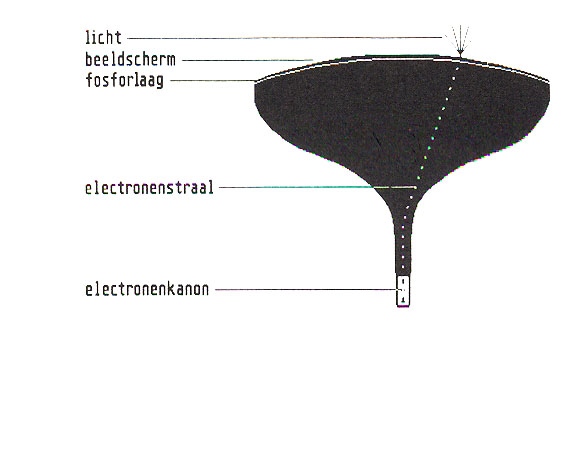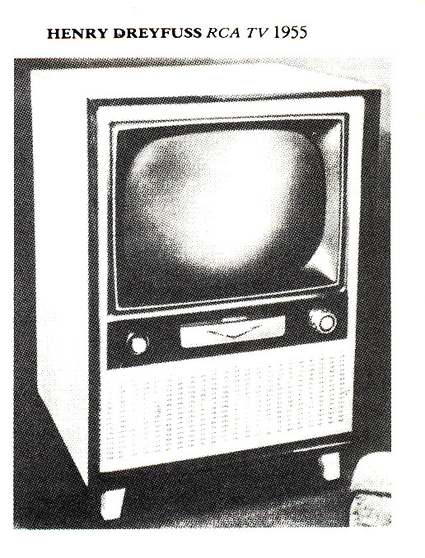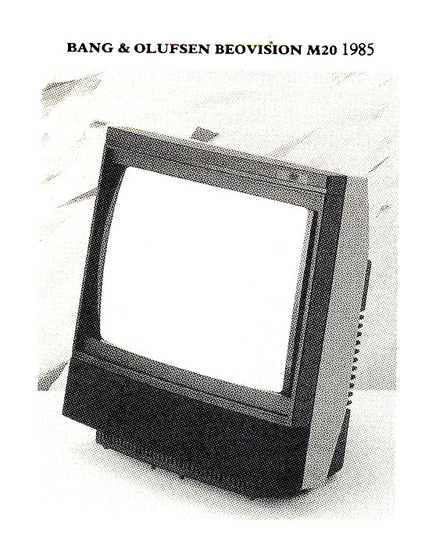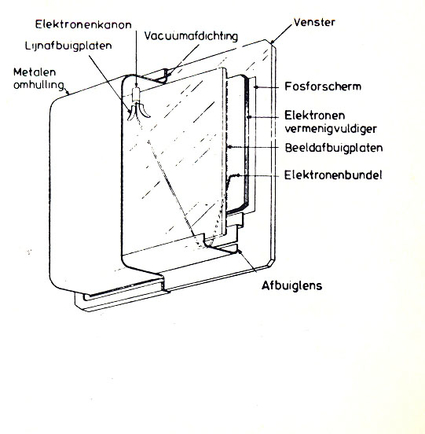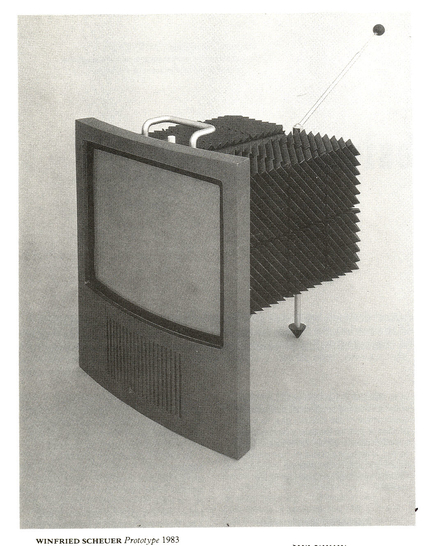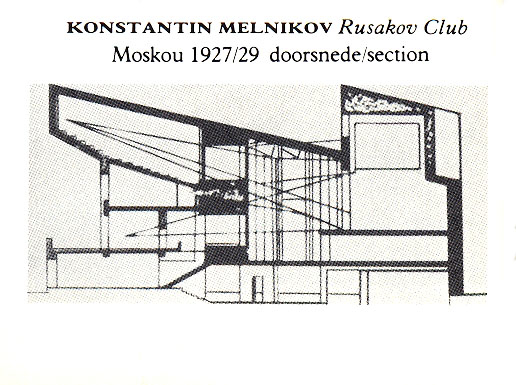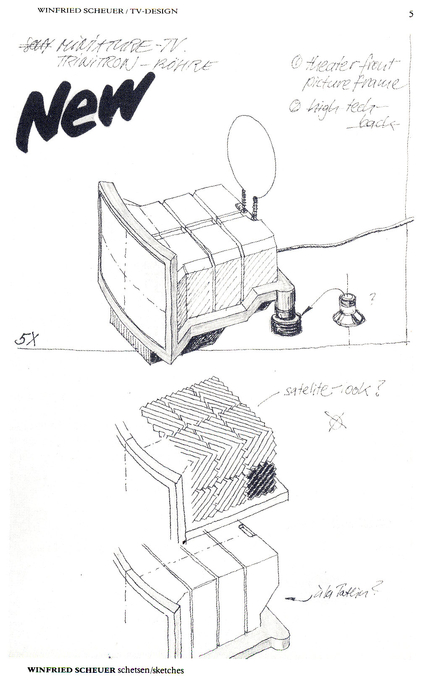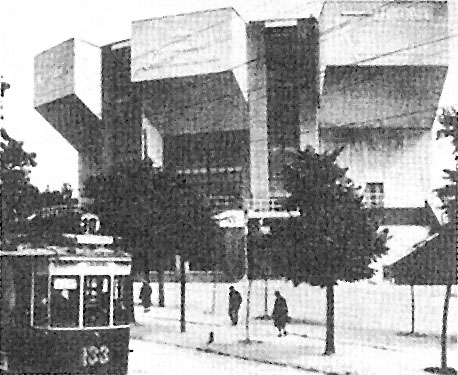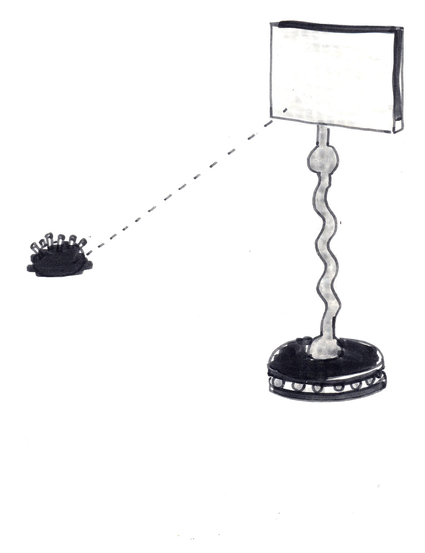Since the rise of television in the fifties, there have been no sensational changes in the form of the television set.
This is for an important part due to the conic picture tube sticking out behind the screen. An essential component of the picture tube is the electron gun, which produces the picture on the screen. The electron gun shoots electrons against the picture screen, causing fluorescent phosphor particles on the screen to light up. To ensure a good quality of the picture, the electron gun has to be at a certain distance from the screen. This causes the lump that we see at the back of the television.
Over the years technological progress has reduced the distance between the screen and the electron gun, but by now the limit has been reached. A flat tube would require either a completely different position and construction of the electron gun, or a new process of picture formation (for example, experiments are under way with the LCD-screen, which produces a picture made up of liquid crystals). In the nineties, television sets with flat tubes will probably be on the market.
Making the back invisible
Except for the professional sector, where a box-like model is current (from which are descended the 'monitor look' living-room sets), television designers have, parallel to the technicians' striving to the flat tube, applied themselves to making the back of the television invisible.
If we compare the form of television from the fifties, sixties, seventies, and eighties, we can clearly see this development. At first, the television set was built in a square case, but gradually this case acquired a more open character. The -usually wooden- frame steadily becomes smaller, while at the back a black component becomes increasingly visible; a plastic casing adapted to the form of the picture tube. The suggestion of a flat television is further enhanced by the fact that the front is of a different color than the back.
Winfried Scheuer
The German designer Winfried Scheuer considers this development from a different angle; not as a reduction of the visibility of the volume occupied by technology, but rather as revealing this technological component.
The next phase in Scheuer's development (1990!) is a television which has a very small frame around the screen, but with a relatively large oblong box that can be seen protruding from the back.
In 1983 he presented a prototype of his concept '1990'. A Sony trinitron picture tube was his point of departure. The screen is situated in the upper part of an oblong front. At the back, at the height of the screen, a ribbed box-like element has been placed. This box is supported by a leg ending in a pointed cap. As a result of the difference in texture, color, and form, front and back seem to be two separate parts. This effect is enhanced by a large grip on top of the television, which seems to invite one to take the front and walk away with it, leaving the back where it was.
In this way, Scheuer's television can also be seen as a logical step in the development towards the flat tube. After separation of the two parts, a flat television is all that remains.
Functional/Expressive
The outspoken contrast between front and back of the television, together with several details such as the large power switch, the handle, the support with its pointed rubber cap, and the ball at the top of the antenna, give a very expressive appearance to Winfried Scheuer's television design. Its form clearly refers to its several functions.
The front looks like the stage in a theatre, inviting one to sit down and wait till the curtain goes up. The (cooling)ribs at the back make a very 'high tech' impression, and refer to the technology inside. The oversized handle, like the ones on glass doors of shops or offices, and the large power switch, leave no doubt as to their function. Scheuer's television can thus be called functional expressionistic.
Melnikov
The sketches show Scheuer's concept of the front part as a theater front, or picture frame. He crossed out high tech back, perhaps because not all the backs designed evoke that association. He wrote satellite look under the sketch showing the ribbed back. A satellite, a miracle of technical and electronic engineering, and indissolubly tied to television broadcasting. By giving a satellite look to the back of the television, he emphasizes its technical nature.
Under the next sketch is written: à la Tatlin? The question mark is appropriate because Scheuer probably means à la Melnikov I have not been able to find any objects by Tatlin that show a marked formal resemblance to Scheuer's design. The design of the back seems rather to have been borrowed from a building by the Russian architect Konstatin Melnikov, namely the Rusakov Club (1927 -29), an educational and social center for workers. After 1915 many of these clubs were built in Russia, on the model of the French maisons du peuple.
Revolutionary and ideological reasons as well as the growing alcohol problem prompted the community councils to build such centres in several districts. They were equipped with reading rooms, concert halls, congress halls, and cinemas. A section of the Rusakov building shows that high up in the sloping part, the public could attend a theatrical performance, a musical show, or a film. By designing his television in this way, Scheuer has turned the viewing situation inside out. The spectator is being watched by the audience in the television. Contrary to the design that was executed, which clearly indicates the practical functions of each component, this design on paper has a more symbolic connotation. The reference to the Rusakov Club gives it the appearance of a theater, or a cinema; a small architectural unit turning out culture. Mass culture, to be sure, working class culture.
Final phase or transition?
Winfried Scheuer turns television into a good-looking object for the living-room. The usually neutral and impersonal box one only pays attention to when programs are being broadcast, is transformed into an interesting and playful object. This is mainly caused by the outspoken contrast between front and back. Therefore I do not think that Scheuer wants to continue along these lines of development towards a flat television. His television, with its back clearly in evidence, is a challenge for designers. It offers many possibilities for design experiments, in contrast to a flat tube.
Still, everything points in a direction where the back of the television will disappear. The volume required to store the technical pans of electronic equipment is decreasing very fast. What remains are the controls (remote control), and, in the case of television, the flat screen ready, as it were, to be hung on the wall. The small quantity of micro-electronics actually doing the work, takes up so little place that it is visually negligible. Therefore, Scheuer's functional-expressionistic design is a dead end.
Designers will have to turn to more symbolic designs (such as the undeveloped Melnikov idea). Form as a metaphor for function.
The theatrical connotations of Scheuer's front already fit in with this concept.
The tactile qualities of the remote control system will also become increasingly important.
All things considered, Scheuer would do better to replace the date of his latest development, 1990, by 1980.
If you'd like to quote something: Possel, Jans. "TV-Design." Mediamatic Magazine vol. 1 # 1 (1986).
Literature:
Hans Friedeman, Het priegelwerk van de platte beeldbuis, in De Volkskrant 11 januari 1986
S. Frederic Starr, Melnikow, solo architect in a mass society, Princeton, New Jersey 1978
R. Baacke, U. Brandes, M.Erlhoff, Design als Gegenstand, und der Glanz der Dinge, Berlijn 1984
Translation: Fokke Sluiter, Groningen
